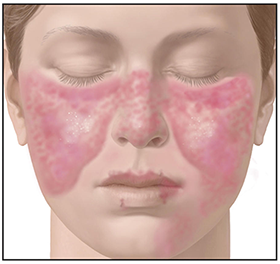Lupus is a chronic autoimmune disease. It can affect multiple organ systems, including the heart, skin, joints, kidneys, and nervous system. There are several types of lupus; in general, when the word lupus alone is used, reference is to systemic lupus erythematosus or SLE, as discussed in this article. Other types include:
” Drug-induced lupus erythematosus, a drug-induced form of SLE; this type of lupus can occur equally in either sex.
” Lupus nephritis, an inflammation of the kidneys caused by SLE.
” Discoid lupus erythematosus, a skin disorder that causes a red, raised rash on the face and scalp. Discoid lupus occasionally (1-5%) develops into SLE.[3]
” Subacute cutaneous lupus erythematosus, which causes nonscarring skin lesions on patches of skin exposed to sunlight.[4]
” Neonatal lupus, a rare disease affecting babies born to women with SLE, Sjögren’s syndrome, or sometimes no autoimmune disorder. It is theorized that maternal antibodies attack the fetus, causing skin rash; liver problems; low blood counts, which gradually fade; and heart block, leading to bradycardia.[4]
Signs and symptoms
SLE is one of several diseases known as “the great imitators”[5] because its symptoms vary so widely, it often mimics or is mistaken for other illnesses because the symptoms come and go unpredictably. Diagnosis can be elusive, with patients sometimes suffering unexplained symptoms and untreated SLE for years. Common initial and chronic complaints are fever, malaise, joint pains, myalgias, fatigue, and temporary loss of cognitive abilities. Because they are so often seen with other diseases, these signs and symptoms are not part of the diagnostic criteria for SLE. When occurring in conjunction with other signs and symptoms (see below), however, they are considered suggestive.[6]
Common symptoms explained
Dermatological manifestations
As many as 30% of patients present with some dermatological symptoms (and 65% suffer such symptoms at some point), with 30% to 50% suffering from the classic malar rash (or butterfly rash) associated with the disease. Patients may present with discoid lupus (thick, red scaly patches on the skin). Alopecia; mouth, nasal, and vaginal ulcers; and lesions on the skin are also possible manifestations.
Musculoskeletal manifestations
Patients most often seek medical attention for joint pain, with the small joints of the hand and wrist usually affected, although all joints are at risk. The Lupus Foundation of America estimates that more than 90 percent will experience joint and/or muscle pain at some time during the course of their illness.[7] Unlike rheumatoid arthritis, lupus arthritis is less disabling and usually does not cause severe destruction of the joints. Fewer than ten percent of people with lupus arthritis will develop deformities of the hands and feet.[7]
Hematological manifestations
Anemia and iron deficiency may develop in as many as half of patients. Low platelet and white blood cell counts may be due to the disease or a side-effect of pharmacological treatment. Patients may have an association with antiphospholipid antibody syndrome (a thrombotic disorder), wherein autoantibodies to phospholipids are present in the patient’s serum. Abnormalities associated with antiphospholipid antibody syndrome include a paradoxical prolonged PTT (which usually occurs in hemorrhagic disorders) and a positive test for antiphospholipid antibodies; the combination of such findings have earned the term lupus anticoagulant-positive. Another autoantibody finding in lupus is the anticardiolipin antibody, which can cause a false positive test for syphilis.
Cardiac manifestations
Patients may present with inflammation of various parts of the heart, such as pericarditis, myocarditis, and endocarditis. The endocarditis of SLE is characteristically noninfective (Libman-Sacks endocarditis) and involves either the mitral valve or the tricuspid valve.Atherosclerosis also tends to occur more often and advances more rapidly in SLE patients than in the general population.[8][9][10]
Pulmonary manifestations
Lung and pleura inflammation can cause pleuritis, pleural effusion, lupus pneumonitis, chronic diffuse interstitial lung disease, pulmonary hypertension, pulmonary emboli, pulmonary hemorrhage, and shrinking lung syndrome.

